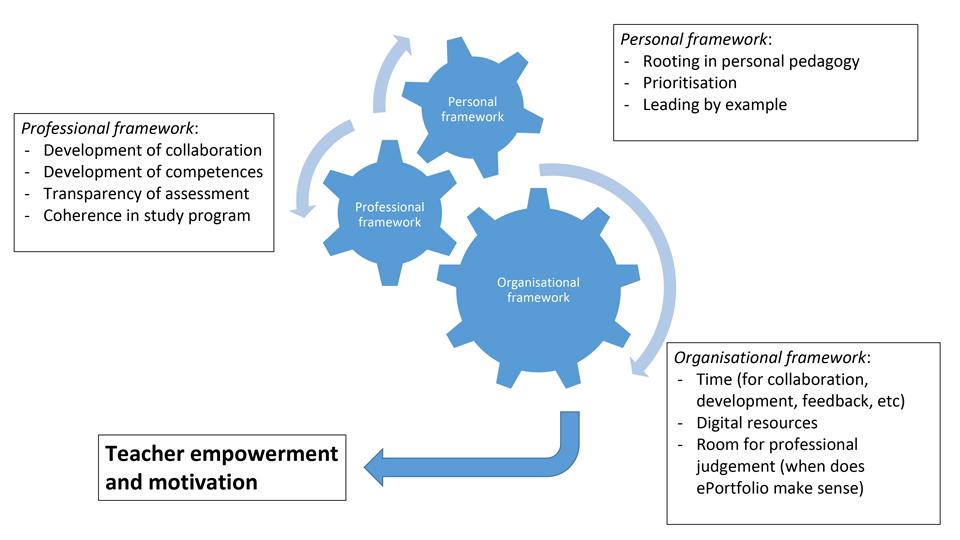
Klindt Poulsen
Introduction and context
The following case discusses the necessary conditions for implementing ePortfolio in teachers’ work at the Program for Vocational, Educational and Career guidance at VIA University College in Aarhus, Denmark. The program is a diploma program in the Faculty of Continuing Education. Thus, the students are all professionals, most of them with a Bachelor’s degree in teaching, social work, pedagogy or similar. Others hold Master’s degrees, typically in the humanities or social sciences. The program consists of 60 ECTS, distributed across three mandatory courses, two to three elective courses and a final thesis. The teachers connected with the program all hold relevant Master’s degrees in career counselling or teaching and learning and include a mixture of relatively new teachers and very experienced teachers, all with previous work experience in the field of career guidance.
After each module, the students are examined, and they are assessed according to a national set of knowledge, skills and competences. Thus, no fixed curriculum exists; instead, the teachers plan the content of each module in order for the students to be able to obtain the appropriate competences. Knowledge could be “knowledge on theories, methods and practices in career guidance”; skills could be “the ability to use theoretical and methodical approaches to career guidance”; competences could be “to identify own learning needs and develop own knowledge, skills and competences”.
Until now, ePortfolios or other digital variants have not had a place in either content or assessment of the courses in the program. The standard way of examining the students’ competences is through oral exams and/or written essays.
Quite a few of the competence goals that are set for each of the courses in the program are connected with transversal skills, such as critical thinking, (professional) communication and organisational competence. Competencies and skills like these are notoriously hard to evaluate in a classic academic essay and in a short oral examination. Therefore, the ePorfolio understood as the integration of both workspace and showcase (Barrett 2010) seems to be able to, if not solve but enhance both the students’ possibilities of actually demonstrating their acquired competences and the teachers’ ability of actually assessing these competencies in a more precise way, with a stronger emphasis on the learning process towards the final product, rather than the contemporary focus on a finite output (e.g. an essay).
Obviously, the shift from a rather traditional way of thinking about organisation of courses, content and evaluation, to an ePortfolio-based form with a very student-centred focus on learning processes (Kunnari, Laurikainen, Pires, & Rodrigues 2017) is not done overnight. To secure a successful transformation, a lot of work needs to be done in (at least) three areas at the Faculty of Continuing Education at VIA University College: in the organisational framework, in the professional framework and in the personal framework (Figure 1).

The organisational level
When it comes to the question of the organisational framework, teachers at the Program of Vocational, Educational and Career Guidance identify the following preconditions for integrating ePortfolio in their daily work; Time, Digital resources and room for professional judgement.
The question of time of course has to do with time to learn and time to implement new ideas on teaching, learning and assessment, and obviously the organisation, or rather the management level, must be able to provide and prioritise a proper amount of time for this process. However, the aspect of time also has to do with a more fundamental understanding of ePortfolio as a learning space. If teachers experience the introduction and prioritisation of ePortfolios by managers as a means to save money on teaching and preparation time, the motivation and engagement for working with ePortfolio drops, and the possibilities of implementing and realising the learning and collaboration potential of ePortfolios decrease. In short, new and innovative ways of teaching need to be supported which, in the short term, may not decrease the amount of work undertaken by teachers, as there is a learning curve with any new initiative.
Consequently, teachers need to see that time for collaboration (with students, with peers, with experts in didactics, with technological support, etc.) is recognised and prioritised as a critical function by their managers. Teachers also need to experience that the time for development of ePortfolios fits the local context and is recognised and prioritised by management. Often, central platforms or tools are bought by institutions and the teachers are more or less obliged to use the platforms they have not chosen themselves. Time is needed for teachers to make the platform or tool fit the needs of the teaching situation and the learning requirements of the students, and not the other way around – in other words, pedagogy before technology. This process must also be recognised as an integrated and time-consuming task for the teacher.
Furthermore, teachers need their managers to provide them with room for making professional judgement on when it is appropriate to use ePortfolios. As the Empowering ePortfolio Process project has shown, ePortfolio must not be considered a tool that is applicable to each and every teaching and learning situation; rather, the professional judgement of teachers must be able do decide when and how it is didactically and pedagogically relevant to use ePortfolios. Trust in the professional competences and judgment of teachers is thus required from the management. Trust, in lieu of a requirement to apply ePortfolio in all instances, indiscriminately of the pedagogical meaning in the concrete situation.
The professional level
The important factors for teacher motivation and empowerment in the professional framework were identified as: Development of collaboration, development of competences, Transparency of assessment and Coherence in study program. For teachers at the Program in Educational, Vocational and Career Guidance the first factor – collaboration – stands before anything else and is the foundation, which the following three factors can be built on.
Implementation of ePortfolio in the teaching practices of the program must be seen as a collaborative endeavour. To foster motivation and engagement for teachers it is important that the ePortfolio work does not become privatised and the responsibility of the single teacher. Instead, a professional community of collaboration must be the starting point for implementing ePortfolio with the teaching staff. A collaboration where ideas, inspiration, tasks, questions, problems and challenges can be discussed, developed and handled collectively, so that not one single teacher bears the whole responsibility of these processes. Research on professional communities and learning communities for the last twenty years show how motivation and engagement are closely linked to taking part of a meaningful (professional) community (Wenger 1998; Clarke & Hollingsworth 2002; Harris & Jones 2010; Pyhältö, Pietarinen, & Soini 2015) and that must also be the starting point for ePortfolio in teachers’ work.
Consequently, a professional community collaborating on ePortfolio will also be the place for developing, sharing and supporting competences relevant for working with ePortfolio. Of course, digital competences in working with and understanding different tools and platforms for ePortfolio are central. However, new knowledge on learning and teaching, development of new practices in assessment (of competences) – assessments that are transparent, both to the students and the teaching staff and are a collaborative effort – and securing coherence in the program, so that the content and progression of the program support the principle of ePortfolio throughout he program, are also vital factors that can emanate from the professional community.
The factors of the professional framework work at a meso-level, requiring both the support of the organisation and the individual teacher. As noted above, professional communities and professional collaboration require time and recognition from the management – it must be respected as a real and equal-ranking task, allocated with a proper amount of time. However, the individual teacher must herself understand the participation in professional communities as a real and equal-ranking task.
The individual level
Finally at the personal level of the framework, the teachers on the program identified the following factors as central to motivation and engagement; Rooting in personal pedagogy, prioritisation and leading by example.
To root the work with ePortfolio in one’s personal pedagogy is of course closely linked to the question of securing room for professional judgement, as discussed above. In order to create motivation and engagement, management must show trust and confidence in the teacher’s professional judgement of the relevance of using ePortfolios (or other digital learning tools). However, if ePortfolios are to become more than just another “tool”, more than just an external demand required by the organisation, they must become rooted in the personal pedagogy of the teacher. The work in professional communities is one important way of discussing and handling this bedding in the personal pedagogy, but it also remains a work for the individual teacher, taking on and understanding how ePortfolio can play a part and be internalised as an integrated part of the pedagogical philosophy or ideology of the teacher. How (if at all?) can ePortfolios support the values and the philosophical ends and objectives that form my teaching practice? If we consider teaching a normative practice (and there is every reason for that), then this is the fundamental question we must ask (Biesta 2014; Biesta 2010).
From the question of rooting ePortfolio in one’s personal pedagogy emerges the question of prioritisation and leading by example. If the ePorfolio is rooted in the teacher’s personal pedagogy in a meaningful way, in a way where ePortfolio work makes sense in both a teaching and learning perspective (Poulsen & Dimsits 2017), then important steps for implementing and sustaining the use of ePortfolio could be prioritisation and leading by example by the individual teacher.
Prioritisation is obviously linked with the discussion above on time and recognition of work tasks, but even if the organisational level is supportive, and the practice of ePortfolio rooted in one’s personal pedagogy (and the professional community supportive and inspiring), the real change must come from actively trying out, challenging, exploring and evaluating the use of ePortfolio in one’s daily practice of teaching. The courage of changing practice through a digital leap into the dark must be present. This is, of course, less difficult with solid support from the organisational level and the professional community, however, one must embrace it oneself.
Finally, and perhaps the most demanding factor, one must consider the effect of taking personal responsibility and ownership of ePortfolios and lead by example. One central way of understanding and learning about the potentials of ePortfolios (also the potentials to one’s teaching philosophy) is perhaps not just by requiring the students to utilise ePortfolios, but to integrate it into one’s own professional practice. That is, actually building an active ePortfolio collecting teaching practices, career perspectives and experiences. Thereby both gaining the hands-on insights in the strengths and weaknesses of ePortfolio practice but by gaining a higher degree of credibility among the students by the creation of a teaching portfolio.
Conclusion
Not surprisingly, the question of teacher motivation and engagement in ePortfolio work is as complex and intricate as the question of student motivation (Kunnari, Laurikainen, Pires & Rodrigues 2017). For teachers at the Program of Educational, Vocational and Career Guidance working implementing ePortfolio in their teaching practice the process operates on (at least) three levels: an organisational level, a professional level and a personal level.
As the picture of the framework of teacher motivation and engagement with ePortfolio seeks to demonstrate, the three levels are deeply intertwined and depend on each other. For instance, time is an issue on all three levels, in all three elements. Moreover, as the figure indicates, the time management issues presuppose each other on each level: to create room and possibility for teacher motivation and engagement towards ePortfolio, organisational and managerial recognition and prioritisation of time is of the essence. However, on the professional level, it is important how that time is spent, and prioritising a professional community to collaborate, share and develop competence in ePortfolios is of great importance for motivation and engagement. Finally, commitment to a professional community demands personal initiative and clarification of the pedagogical values on which one’s professional practice is founded.
Therefore, implementing ePortfolio practice in the daily work of a teacher is not just about technical insight or the common (managerial) misconception that digitalisation of education is able to save money and increase effectiveness with the snap of one’s fingers. Rather, it is a process deeply rooted in professional concepts such as didactic and pedagogic theory and ideology, and it is a process perpetually played out between the frameworks of the organisation, the profession and the individual.

This article was produced in the Erasmus+ (KA2 action) funded project “Empowering Eportfolio Process (EEP)”. The beneficiary in the project is Häme University of Applied Sciences (FI) and the partners are VIA University College (DK), Katholieke Universiteit KU Leuven (BE), University College Leuven-Limburg (BE), Polytechnic Institute of Setúbal (PT) and Marino Institute of Education (IE). The project was implementated during 1.9.2016–30.11.2018.
Author

Bo Klindt Poulsen is Associate Professor in the School of Continuing Education at VIA University College. He is also a PhD student at Aarhus University, researcher at Research Centre for Lifelong Learning (VIA UC), head of the research programme in career guidance, and currently working on a research project on cooperation in career guidance.
References
Barrett, H. (2010). Balancing the two faces of ePortfolios. Educação, Formação & Tecnologias, 3(1), 6–14.
Biesta, G. J. J. (2010). Good education in an age of measurement: ethics, politics, democracy. London: Routledge.
Biesta G. J. J. (2014). The beautiful risk of education. London: Routledge.
Clarke, D. & Hollingsworth, H. (2002). Elaborating a model of teacher professional growth. Teaching and Teacher Education, 18, 947–967.
Harris, A. & Jones, M. (2010). Professional learning communities and system improvement. Improving Schools, 13, 172–181.
Kunnari, I., Laurikainen, M., Pires, A. O., & Rodrigues, M. R. (2017). Supporting students’ ePortfolio process in Higher Education. In I. Kunnari & M. Laurikainen (eds.) Students’ perspectives in ePortfolios. HAMK Unlimited Journal 12.12.2017. Retrieved 14 May 2018 from https://unlimited.hamk.fi/ammatillinen-osaaminen-ja-opetus/supporting-students-eportfolio-process-in-higher-education
Poulsen, B. K. & Dimsits, M. (2017). Making sense with ePortfolios. In I. Kunnari & M. Laurikainen (eds.) Students’ perspectives in ePortfolios. HAMK Unlimited Journal 20.12.2017. Retrieved 14 May 2018 from https://unlimited.hamk.fi/ammatillinen-osaaminen-ja-opetus/making-sense-with-eportfolios
Pyhältö, K., Pietarinen, J., & Soini, T. (2015) Teachers’ professional agency and learning – from adaption to active modification in the teacher community. Teachers and Teaching, 21(7), 811‒830.
Wenger, E. (1998). Communities of practice: Learning, meaning and identity. New York, NY: Cambridge University Press.





